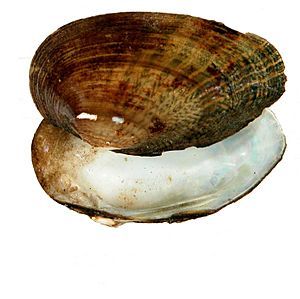Gulf moccasinshell facts for kids
Quick facts for kids Gulf moccasinshell |
|
|---|---|
 |
|
| Conservation status | |
| Scientific classification | |
| Genus: |
Medionidus
|
| Species: |
penicillatus
|
The gulf moccasinshell (Medionidus penicillatus) is a very rare type of freshwater mussel. It is a kind of aquatic bivalve mollusk, which means it's a soft-bodied creature with a two-part shell. This special mussel lives in rivers and streams.
It is found in Alabama, Florida, and Georgia in the United States. Sadly, its numbers are going down, and it has disappeared from many rivers where it used to live. Because it is so rare, the United States government has listed it as an endangered species. This means it needs special protection to survive.
What It Looks Like
This mussel can grow up to about 5.5 centimeters (about 2 inches) long. Its shell is usually yellowish or greenish-brown. It often has cool green stripes, like rays of light.
Inside, the shell has a shiny, pearly lining called nacre. This nacre can look purplish or greenish. Sometimes it shimmers with different colors, which is called iridescence.
Where It Lives
The gulf moccasinshell is originally from the ACF River Basin. This is a large watershed where the Apalachicola, Chattahoochee, and Flint Rivers flow. This area is where the states of Alabama, Georgia, and Florida meet.
Its home range has shrunk by 80% from what it used to be. Today, there are fewer than 20 places where it is found. Even in those places, it is not common. You can still find it in parts of the Flint and Chattahoochee Rivers. It also lives in four smaller streams that flow into these rivers, and in Econfina Creek. It has almost completely disappeared from the state of Alabama.
Life Cycle and Reproduction
Like other mussels, the gulf moccasinshell has a unique way of reproducing. It releases tiny larvae called glochidia. These glochidia attach themselves to the gills of certain fish. They stay there and grow into young mussels.
Once they are big enough, the young mussels drop off the fish and settle on the riverbed. There, they continue to grow into adult mussels.
Some of the fish that help the gulf moccasinshell grow include:
- Etheostoma edwini (brown darter)
- Percina nigrofasciata (blackbanded darter)
- Gambusia holbrooki (eastern mosquitofish)
- Poecilia reticulata (guppy)
- Etheostoma inscriptum (turquoise darter)
- Etheostoma swaini (Gulf darter)
- Percina crypta (Halloween darter)
See also
 In Spanish: Medionidus penicillatus para niños
In Spanish: Medionidus penicillatus para niños


